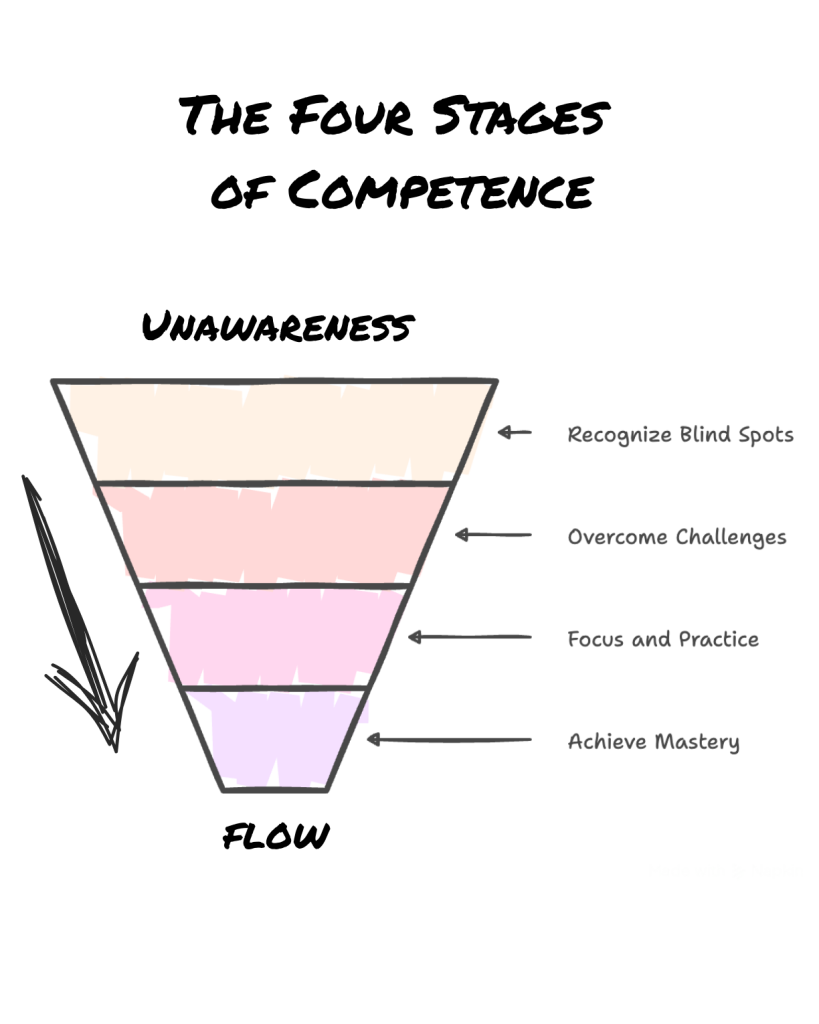I remember the first time I opened ChatGPT a couple years ago. I sat there staring at that blank prompt box, not really sure what to type.I can’t even remember what I asked. But what came back? Mind-blowing and awkward at the same time. A few more attempts and I thought: “The demos I’ve seen online look way better than this. I must be doing something wrong.”
Sound familiar?
You see, every time you learn something new, there’s a moment where you feel like it’s getting worse. That’s not failure. It’s science.
When you try to master a new skill — whether it’s driving, leading a team, or figuring out AI—you hit a strange and discouraging wall.
It feels like you’re getting worse.
Your confidence dips, your mistakes multiply, and you start asking: “Am I cut out for this?”
That sinking feeling isn’t failure. It’s psychology. In fact, it’s the best sign you’re on the right track.
Because every skill in life follows the same hidden ladder of competence—a four-stage climb that explains why growth almost always feels harder before it feels easier.
Once you understand the rungs of this ladder, you’ll stop dreading discomfort and start using it. And by the end of this article, I’ll give you five-minute exercises that can help you accelerate your climb.
So let’s start where it always begins: that first shaky step.
The First Time Behind the Wheel
Let’s take a trip down memory lane. Think back to your first driving lesson. Both hands on the wheel at 10 and 2 o’clock. Knuckles white. A bead of sweat forming at your temple, and a lump in your throat.
Every little thing that you did required conscious effort: mirror, signal, check blind spot, “where the hell are the windshield wipers?”
It felt overwhelming.
Compare that to years later, when you drive to work and barely remember the trip—your brain free to think about tomorrow’s meeting, when Taylor Swift’s new album is dropping, or your weekend plans.
That shift from “every step is a struggle” to “it’s second nature” is the ladder of competence at work. Originally described in the 1970s by Noel Burch at Gordon Training International, the model explains why growth is rarely linear: progress requires discomfort.
BUT discomfort is a good thing. It’s your signal that you’re growing. “I’m growing because it’s easy” — said no one, ever.

That’s why you climb the four rungs of the competence ladder. Miss one, and you stall. Understand them, and you’ll climb faster—whether you’re learning to lead with AI, rebuilding your career, or finally mastering golf.
So let’s jump in.
Stage 1: You Don’t Know What You Don’t Know — The Dangerous Comfort Zone
You don’t know what you don’t know. (Or at this stage, you don’t know anything at all 😅.) You’re blissfully unaware of your blind spots.
Golf is a good example for me. On TV it looks great. How hard can it be to hit a ball right?
Yeah. Painful. Reality quickly comes around and you realize that that ball is seemingly smaller than you thought. Or maybe it’s the club.
This is where the Dunning–Kruger effect often strikes. The concept comes from a paper by psychologist David Dunning and Justin Kruger (1999) who’s tests showed that beginners tend to overestimate their abilities because they lack the knowledge to see their shortcomings.
In practice: You’re using ChatGPT like Google search, missing its deeper capabilities—workflow automation, strategic scenario planning, or communication drafting.
5-Minute Action: Choose one area where you feel most confident. Use a LLM (ChatGPT, Claude, Perplexity) and ask “ what are common mistakes in [that area].” You’ll likely uncover blind spots you didn’t know existed.

Stage 2: You See the Gap and It Feels Impossible — The Growth Zone
All of a sudden, the blindfold comes off. You realize how far you have to go. It’s uncomfortable, even crushing. This is where most people quit. Because ignorance was bliss, and now you can see exactly how much you don’t know. The gap between where you are and where you need to be feels impossible.
This stage is where most people quit. But it’s also where true growth begins. Let me show you what happens when you stay stuck in Stage 2 versus what happens when you push through. Kodak’s engineers built the first digital camera back in 1975. Leadership saw the future coming—and shelved it. Why?
To protect film sales when smartphones turned everyone into a photographer, Kodak knew they had a problem. The gap between where they were and where they needed to be was painfully obvious. They could’ve climbed. Instead, they doubled down on what felt comfortable. You know how that story ends.
Apple? Completely different. When mobile took off, they didn’t protect the iPod. They rebuilt the entire company around the iPhone — new skills, new org. structure, new incentives. They leaned into the discomfort and came out the other side as the most valuable company on earth. Same stage. Same uncomfortable gap. Completely different choices.
You’re standing at the same crossroads right now. The question isn’t whether the gap feels impossible. The question is: what are you going to do about it?
As Brad Stulberg puts it in The Practice of Groundedness, “Progress in anything, large or small, requires recognizing, accepting, and starting where you are.”
In practice: Let’s say you’re an exec or manager with 20 years of leadership experience. All of a sudden you need to guide your team on AI adoption, but can’t, because you barely understand the basics of prompting. The gap might feel embarrassing. But this awareness is where your growth really starts.
5-Minute Action: Write down three skills you know you’re weak in but keep avoiding. Circle the one that scares you most. That’s your biggest growth opportunity.
Stage 3: You Can Do It, But It Takes Focus — The Effort Zone
Now we’re moving and groovin. You can perform the skill, but only with focus. Think of those early months of driving, where every action required deliberate thought.
This stage creates a bottleneck. As James Clear notes in Atomic Habits, “The conscious mind is the bottleneck of the brain. It can only pay attention to one problem at a time.”
Let’s say you’re learning to play tennis. If you’re just learning how to serve it’s a process. You toss the ball, adjust your grip, remind yourself to bend the knees, follow through. Every little movement requires deliberate thought. You might manage to get the ball over the net, but your brain is working overtime to focus, all of which feels exhausting. This is Stage 3 in action: you can perform, but it costs you attention and energy.
In practice: At this stage you need to start building systems. Document your process step by step. Let’s take our AI example. Maybe it’s using AI to summarize reports, building a repeatable way to prep for meetings, or outlining how you review outputs. That “playbook” doesn’t just make you faster; it’s the blueprint for automation or delegation.
5-Minute Action: Identify one task that always feels slow and effortful. Write down the 3–5 steps you usually take. Congratulations—you’ve started turning effort into a repeatable system.
Stage 4: The Skill Becomes Automatic — The Flow Zone
Now we’re in the zone. After enough repetition, the skill runs on autopilot. Your body and mind know what to do without conscious effort.
This, my friend, is the realm of mastery—and innovation. When the basics run automatically, your mind is free to focus on strategy, creativity, and leadership.
Steph Curry, the NBA’s all-time leader in 3-point shots, makes hitting deep threes look effortless. But what looks automatic in games comes from relentless practice. It’s said he often takes 500 shots a day, adding up to millions over his career. Mastery and flow isn’t magic—it’s repetition so ingrained that performance flows without thought.

In practice: Senior leaders who integrate AI as naturally as email. They don’t “use AI”; they lead with it—like Reid Hoffman’s “Superagency” concept, where AI is integrated so naturally it becomes an extension of individual human capacity. You’re firing on all cylinders, but making sure that you can continue learning.
5-Minute Action: List three things you do automatically in your work. When did you last update those skills? If the answer is years ago, it’s time to refresh before complacency turns mastery into irrelevance.
How to Climb the Ladder Faster: 6 Research-Backed Strategies
Here’s how to climb the learning ladder faster, backed by research and practical performance practices:
Growth happens in the stretch zone, not in the comfort zone or the panic zone.
- Find Your Optimal Challenge Level — Aim for tasks that “just barely exceed your ability.” If you feel fully in control, increase the challenge. If you feel anxious or overwhelmed, dial it back slightly. As outlined in Peak Performance by Brad Stulberg & Steve Magness, this “performance practices” checklist is simple:
- think of the skill you want to grow,
- assess your current ability,
- and then actively seek out challenges that push you just past comfort.
Growth happens in the stretch zone, not in the comfort zone or the panic zone.
- Master Through Focused Repetition — Treat mastery as narrowing your focus to one small element, repeating it until it’s automatic, and then building on top. James Clear describes this in Atomic Habits: mastery is the process of getting your reps in. A tennis player might spend hours just practicing toss and serve mechanics; in the same way, you can break down any skill into small chunks and layer them over time.
- Build Habits to Free Your Bottleneck — Automate low‑stakes choices and routines so you can spend your best energy on the hard stuff. Robin Sharma in The 5 AM Club notes that top performers eliminate trivial decisions—what to wear, what to eat—so they can concentrate on what really matters. The same applies to leadership and learning: automate the basics, preserve your bandwidth for high‑stakes challenges.
- Teach to Expose Gaps — Explaining what you’re learning quickly shows what you don’t yet grasp. As Sahil Bloom says, “The act of teaching is the most powerful form of learning.” Try teaching a concept to a colleague or friend. Notice where you stumble or where their questions expose gaps. That’s your next practice target.
- Schedule Deliberate Practice — High performers don’t leave learning to chance; they build a curriculum for themselves. Brendon Burchard’s research in High Performance Habits shows top leaders literally schedule blocks of time for study, coaching, or skill‑building hobbies. Whether it’s one hour for a course, 30 minutes for AI experiments, or a weekly review, put learning in your calendar.
- Quiet Self 1 to Unleash Self 2 — Timothy Gallwey’s The Inner Game of Tennis highlights the tension between “Self 1” (the overthinking, judging mind) and “Self 2” (the natural, trained self). To perform at your best, you need to let Self 2 flow. Adopting a performance‑approach mindset helps: focus on the task, the potential rewards, and immerse yourself until action feels fluid. Overthinking blocks execution; trust your reps.

The Hardest Stage Is the Best One
If you’re feeling stuck, clumsy, or overwhelmed in your growth—don’t quit. You’re not failing. You’re just in Stage 2. That’s your signal. You’re on the ladder and you just need to keep going.
Whether you’re learning to drive, leading with AI, or reinventing your career, remember: discomfort is the clearest signal that you’re on the ladder.
Takeaway: Growth feels worst just before it works. The discomfort isn’t a sign you’re failing. It’s proof you’re climbing. Stay on the ladder.
FAQ
When you move from unconscious incompetence (not knowing what you don’t know) to conscious incompetence (aware of the gap), you suddenly see how much you need to learn. This awareness feels like regression, but it’s actually the first step toward real growth. Psychologists call this the “ladder of competence”—a four-stage model that explains why discomfort is a sign you’re progressing, not failing.
The four stages are: (1) Unconscious Incompetence—you don’t know what you don’t know; (2) Conscious Incompetence—you realize the gap and it feels uncomfortable; (3) Conscious Competence—you can perform with effort and focus; (4) Unconscious Competence—the skill becomes automatic and flows naturally. Most people quit at Stage 2, but that’s exactly where growth begins.
AI accelerates learning by helping you identify blind spots (ask an LLM “what are common mistakes in [skill area]”), build repeatable systems (document processes step-by-step), and get instant feedback on your work. Use AI to move through the conscious competence stage faster by creating templates, workflows, and practice scenarios that turn effortful tasks into automatic habits.





